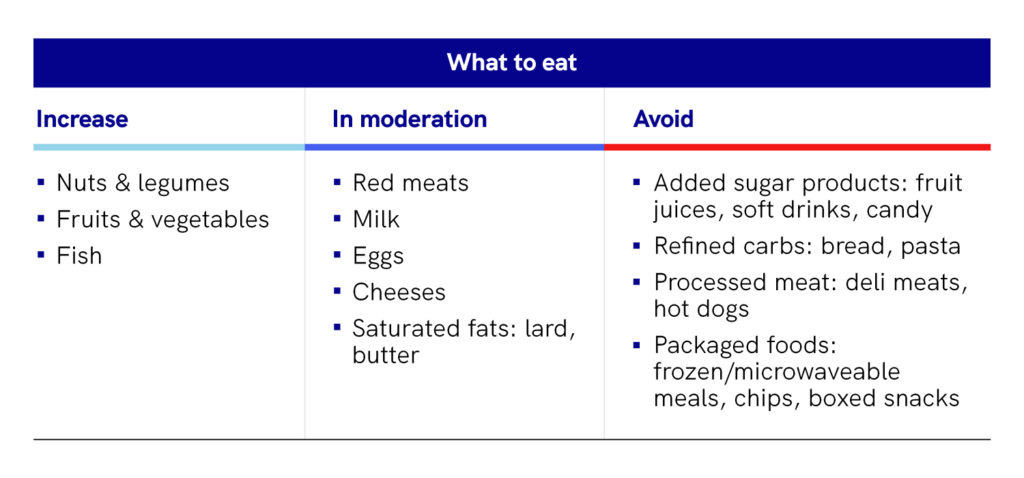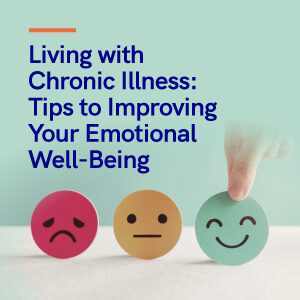On average, the heart pumps about 2.5 billion times over your lifetime, moving millions of gallons worth of blood through the highway of blood vessels that reach each and every cell in your body. This network represents your cardiovascular (CV) system, which can be affected by a number of diseases like heart attacks, stroke, heart failure, arrhythmias, and heart valve problems. In the United States, someone has a heart attack every 40 seconds, and cardiovascular disease is considered the number one killer of both men and women. Although genetics plays a role cardiovascular disease risk, many lifestyle factors can prevent or accelerate the development of disease. About 80% of all heart disease cases are considered preventable through meaningful lifestyle changes. Your heart works for you every second of every day – so consider these five ways you can show it some love and help it work more effectively for you!
1. Eat healthier foods
Fad diets and dubious health misinformation about many foods makes it difficult to navigate the best way to eat healthy. Keeping it simple and focusing on whole foods and items with simple ingredients is an easy rule of thumb to follow. In general, increasing healthy fats in your diet, like those from nuts, olive oil, avocados, and fatty fish are great for your health. Also, you should reduce saturated fats from red meats and focus more on leaner meats like poultry. Packaged foods are particularly problematic – the options are endless, it’s easy to eat large servings, and they are packed with extra salt, sugar, and preservatives. Avoiding these can make a huge difference in the amount of calories, sugar and salt you eat, and lead to a drastic improvement in health.

2. Exercise – any amount helps!
Research shows a very strong relationship between physical activity and decreased heart disease risk. This is particularly important with aging, and unfortunately many Americans live mostly sedentary lives. According to the CDC, the ideal dose of exercise each week is 150 minutes of moderate-intensity aerobic exercise and two 30-minute sessions of resistance training. This aerobic exercise can be anything that gets your heart rate up – like running, swimming, brisk walking, biking or even doing yard work. Resistance training focuses on strengthening your key muscle groups so lifting weights, using resistance bands, or bodyweight exercises are a great way to build strength. This probably seems like a lot for most people, so the important thing is to start small and work up to this goal. Even just ten minutes a day – or taking the stairs instead of the elevator – can be enough to have a noticeable effect. A recent study in almost 80,000 participants from ages 40 to 69 showed that just two minute bursts of vigorous activity totaling 15 minutes in a week actually reduced the risk of cardiovascular disease by 15% over a five-year period.(1) More physical activity had an even greater effect, with intensity and frequency being key to seeing positive effects. Many clinical trials have also shown that heart disease patients that enroll in exercise-based rehab programs are less likely to be hospitalized within the following 12 months than patients in non-exercise programs.(2) The sooner you integrate exercise into your life, the longer you will reap the benefits for your health.
3. Keep your cholesterol in check
Cholesterol is a fat molecule made by your liver and found in some foods. The two main types are high-density lipoprotein (HDL) cholesterol (good) and low-density lipoprotein (LDL) cholesterol (bad). Cholesterol is very important for your cell to function, but too much of it in the blood leads to accumulation along the artery walls, creating plaques that can limit blood flow and also raise blood pressure. If a piece of the plaque breaks off, it can cause of heart attack or stroke if it gets stuck in one of your blood vessels and restricts blood flow. Aiming for LDL cholesterol levels below 70 mg/dL and triglyceride levels under 150 mg/dL is ideal for maintaining cardiovascular health. High triglycerides are mostly caused by high carbohydrate consumption – reducing sugars, pastas, and other refined carbs from your diet can have a significant impact. Many foods can also help lower LDL levels, like fish, nuts, vegetables, and legumes. Regular bloodwork to check your cholesterol and triglyceride levels can help you know if you need to make diet changes or introduce medication to regulate levels.

4. Mind your blood pressure
Blood pressure readings taken on your upper arm measure the force of the blood that pushes through your arteries when your heart contracts (systolic blood pressure, 1st number) and relaxes (diastolic blood pressure, 2nd number). The ideal blood pressure is around 120/80 mm Hg and higher values are indicative of hypertension. Hypertension puts a lot of stress on your blood vessel walls, causing damage and stiffening and weakens your heart, which can ultimately lead to heart failure or stroke. A review of over 120 studies looking at the benefits of lowering blood pressure in over 600,000 participants showed that every 10 mmHg reduction in systolic blood pressure reduced the risk of heart disease by 17% and stroke by 27%.(3) Exercise, losing weight and reducing salt and sugar intake also play key roles in lowering blood pressure. Staying on top of your resting blood pressure with the help of your doctor and taking medications if needed is key. Even if you are living a healthy lifestyle, normal aging causes changes in your blood vessels so it’s important to regularly measure your blood pressure.
5. Reduce alcohol and quit smoking
The use of tobacco products is the most important cardiovascular risk factor according to the American Heart Association. It is the leading cause of preventable death and disease in the United States, causing an estimated 20% of deaths annually.(4) It carries a substantial burden on the healthcare system, even though only 12.5% of the U.S. population smokes (about 42 million people). Smoking harms almost every organ in your body, and seriously damages blood vessels, increases blood pressure, lowers healthy HDL cholesterol and contributing to atherosclerosis. Being a smoker doubles your risk of a heart attack and triples your risk of a stroke compared to non-smokers. Even quitting later in life can significantly lower your risk of cardiovascular disease and improve your overall health. E-cigarettes, which are rapidly rising in popularity since they produce less toxic compounds than traditional smoking, have also been linked to increased cardiovascular risks.(5) Some studies do show that e-cigarette use leads to a harm-reduction benefit when compared to traditional smoking; however the data is mixed with few long-term studies, so ultimately the best option is no tobacco products at all.(6–8)
Consuming more than two alcoholic drinks per day as a male, or one drink per day as a female also increases your risk for cardiovascular disease. Binge drinking is particularly harmful and not all alcohol types are equal, with beer and hard liquors being the worst to consume. Some studies even suggest that moderate wine drinking can actually benefit the heart, by slightly increasing HDL cholesterol levels and showing improvements in other cardiovascular factors, likely due to the antioxidants found in wine.(9) This may seem great, but the bad news is that this is only true in moderation. Overall limiting alcohol intake and eliminating smoking is the best thing you can do for your heart and health.
It’s easy to be overwhelmed and be disappointed if you struggle to introduce healthy habits. But it’s important to remember that the most meaningful change happens incrementally – one small improvement at a time! Introduce one or two small positive habits to your health every few weeks and before you know it, you’ll be feeling great while powering your heart to work more efficiently for you. Make the commitment to show your heart some love so you can keep loving the special people in your life for years to come!
References
- Ahmadi MN, Clare PJ, Katzmarzyk PT, del Pozo Cruz B, Lee IM, Stamatakis E. Vigorous physical activity, incident heart disease, and cancer: how little is enough? European Heart Journal. 2022 Dec 7;43(46):4801–14.
- Long L, Mordi IR, Bridges C, Sagar VA, Davies EJ, Coats AJ, et al. Exercise-based cardiac rehabilitation for adults with heart failure. Cochrane Heart Group, editor. Cochrane Database of Systematic Reviews [Internet]. 2019 Jan 29 [cited 2023 Feb 9];2019(1). Available from: http://doi.wiley.com/10.1002/14651858.CD003331.pub5
- Ettehad D, Emdin CA, Kiran A, Anderson SG, Callender T, Emberson J, et al. Blood pressure lowering for prevention of cardiovascular disease and death: a systematic review and meta-analysis. The Lancet. 2016 Mar;387(10022):957–67.
- Center for Disease Control and Prevention. Tobacco-Related Mortality [Internet]. 2020. Available from: https://www.cdc.gov/tobacco/data_statistics/fact_sheets/health_effects/tobacco_related_mortality/index.htm
- Pipe AL, Mir H. E-Cigarettes Reexamined: Product Toxicity. Canadian Journal of Cardiology. 2022 Sep;38(9):1395–405.
- Farsalinos K, Cibella F, Caponnetto P, Campagna D, Morjaria JB, Battaglia E, et al. Effect of continuous smoking reduction and abstinence on blood pressure and heart rate in smokers switching to electronic cigarettes. Intern Emerg Med. 2016 Feb;11(1):85–94.
- Benowitz NL, Liakoni E. Tobacco use disorder and cardiovascular health. Addiction. 2022 Apr;117(4):1128–38.
- Rezk-Hanna M, Warda US, Stokes AC, Fetterman J, Li J, Macey PM, et al. Associations of Smokeless Tobacco Use With Cardiovascular Disease Risk: Insights From the Population Assessment of Tobacco and Health Study. Nicotine Tob Res. 2022 Jun 15;24(7):1063–70.
- Gepner Y, Golan R, Harman-Boehm I, Henkin Y, Schwarzfuchs D, Shelef I, et al. Effects of Initiating Moderate Alcohol Intake on Cardiometabolic Risk in Adults With Type 2 Diabetes: A 2-Year Randomized, Controlled Trial. Ann Intern Med. 2015 Oct 20;163(8):569–79.

